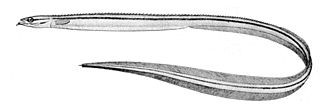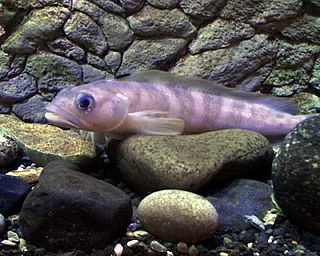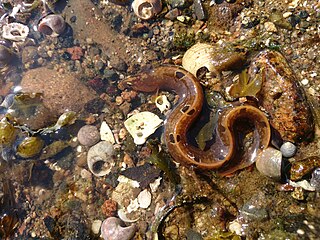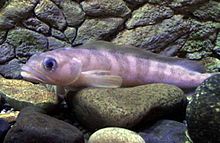
Ronquils is a small family marine ray-finned fish, the Bathymasteridae. These fishes are found only in Arctic and North Pacific waters. This family contains just seven species in three genera. The larger species are important to commercial fisheries as food fish. Ronquils are most closely related to the eelpouts and prowfish in the suborder Zoarcoidei of the order Scorpaeniformes.

Pholidae is a family of marine ray-finned fishes, known as gunnels, in the scorpaeniform suborder Zoarcoidei. These are fishes of the littoral zone and are mainly found in North Pacific Ocean, with two species found in the North Atlantic Ocean and Arctic Ocean.

The quillfish,, is a species of marine ray-finned fish, it is the only species in the genus Ptilichthys and family Ptilichthyidae. This fish occurs in the northern North Pacific Ocean.

The stripedfin ronquil, also known as the bluebanded ronquil, is a species of marine ray-finned fish belonging to the family Bathymasteridae, the ronquils. This fish is found in the eastern Pacific Ocean.

Cryptacanthodes is a genus of marine ray-finned fishes belonging to the monogeneric family Cryptacanthodidae, commonly referred to as wrymouths. Three of the four species are found in the Pacific Ocean with one species native to the western Atlantic Ocean where they are benthic fishes, tunneling through soft substrates. It is currently the only known genus in its family.

Bathymaster is a genus of marine ray-finned fishes belonging to the family Bathymasteridae, the ronquils. These fishes are found in the northern Pacific Ocean.

Rathbunella is a genus of marine ray-finned fishes belonging to the family Bathymasteridae, the ronquils. These fishes are found in the eastern Pacific Ocean.

The rock gunnel, or butterfish, is a species of marine ray-finned fish belonging to the family Pholidae, the gunnels. This species is found in the coastal waters of the North Atlantic Ocean and in the Atlantic part of the Arctic Ocean.
The dara is a species of marine ray-finned fish, a grunt belonging to the family Haemulidae. It is native to the Atlantic coast of Africa. It is the only species in the monospecific genus Parakuhlia.

Minous monodactylus, the grey stingfish or grey goblinfish, is a species of marine ray-finned fishes, it is the only genus in the tribe Minoini, one of the three tribes which are classified within the subfamily Synanceiinae within the family Scorpaenidae, the scorpionfishes and their relatives. This species found in the Indo-Pacific and is venomous to humans.

Gvozdarus svetovidovi, the naked-head toothfish, is a species of marine ray-finned fish belonging to the family Nototheniidae, the notothens or cod icefishes. It is found in the Ross and Cooperation Seas, probably south of the Antarctic Polar Front from pelagic waters down to depths of 550 m (1,804 ft), though it is normally found in a pelagic environment.
The stippled gunnel is a species of marine ray-finned fish belonging to the family Pholidae, the gunnels. It is the only species in the monospecific genus Rhodymenichthys. It is found in the northern North Pacific Ocean.

The fourline snakeblenny is a species of marine ray-finned fish belonging to the family Stichaeidae, the pricklebacks and shannies. It is the only species in the monotypic genus Eumesogrammus. This fish is found in the Western North Atlantic, Arctic and North Pacific Oceans.

Stichaeus is a genus of marine ray-finned fishes belonging to the family Stichaeidae, the pricklebacks or shannies. These fishes are mainly found in the North Pacific Ocean with one species in the Arctic and western North Atlantic Oceans.
Stichaeopsis is a genus of marine ray-finned fishes belonging to the family Stichaeidae, the pricklebacks or shannies. These fishes are found in the western North Pacific Ocean.

The Arctic shanny is a species of marine ray-finned fish belonging to the family Stichaeidae, the pricklebacks and shannies. This species occurs in the North Pacific, Arctic and western North Atlantic Oceans.
Askoldia is a monotypic genus of marine ray-finned fishes belonging to the family Stichaeidae, the pricklebacks and shannies. Its only species is Askoldia variegata which is found in the northwestern Pacific Ocean.
Lumpenopsis is a genus of marine ray-finned fishes belonging to the family Stichaeidae, the pricklebacks or shannies. These fishes are found in the North Pacific Ocean.
Pholidapus is a monotypic genus of marine ray-finned fishes belonging to the family Stichaeidae, the pricklebacks and shannies. Its only species is Pholidapus dybowskii which is found in the northwestern Pacific Ocean.
The bearded eelpout is a species of marine ray-finned fish belonging to the family Zoarcidae, the eelpouts. This species is the only species in the monospecific genus Lyconema. It is found in the eastern Pacific Ocean.











